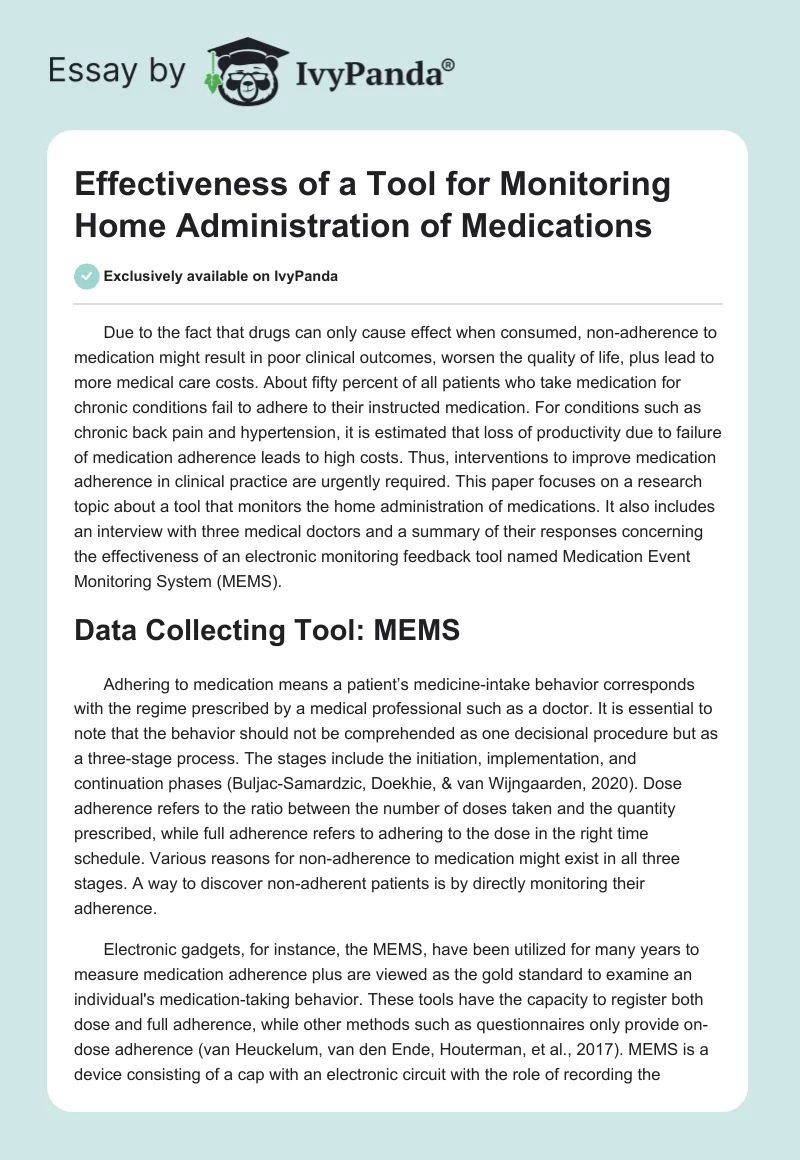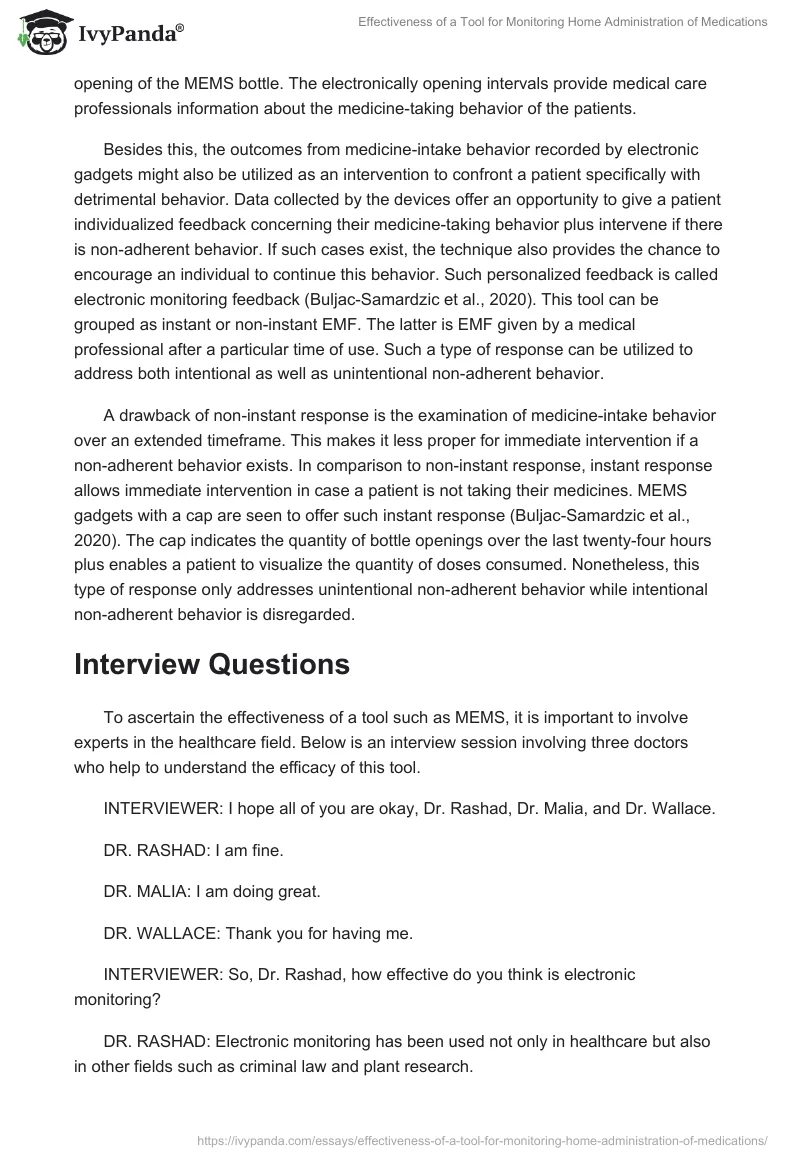Due to the fact that drugs can only cause effect when consumed, non-adherence to medication might result in poor clinical outcomes, worsen the quality of life, plus lead to more medical care costs. About fifty percent of all patients who take medication for chronic conditions fail to adhere to their instructed medication. For conditions such as chronic back pain and hypertension, it is estimated that loss of productivity due to failure of medication adherence leads to high costs. Thus, interventions to improve medication adherence in clinical practice are urgently required. This paper focuses on a research topic about a tool that monitors the home administration of medications. It also includes an interview with three medical doctors and a summary of their responses concerning the effectiveness of an electronic monitoring feedback tool named Medication Event Monitoring System (MEMS).
Data Collecting Tool: MEMS
Adhering to medication means a patient’s medicine-intake behavior corresponds with the regime prescribed by a medical professional such as a doctor. It is essential to note that the behavior should not be comprehended as one decisional procedure but as a three-stage process. The stages include the initiation, implementation, and continuation phases (Buljac-Samardzic, Doekhie, & van Wijngaarden, 2020). Dose adherence refers to the ratio between the number of doses taken and the quantity prescribed, while full adherence refers to adhering to the dose in the right time schedule. Various reasons for non-adherence to medication might exist in all three stages. A way to discover non-adherent patients is by directly monitoring their adherence.
Electronic gadgets, for instance, the MEMS, have been utilized for many years to measure medication adherence plus are viewed as the gold standard to examine an individual’s medication-taking behavior. These tools have the capacity to register both dose and full adherence, while other methods such as questionnaires only provide on-dose adherence (van Heuckelum, van den Ende, Houterman, et al., 2017). MEMS is a device consisting of a cap with an electronic circuit with the role of recording the opening of the MEMS bottle. The electronically opening intervals provide medical care professionals information about the medicine-taking behavior of the patients.
Besides this, the outcomes from medicine-intake behavior recorded by electronic gadgets might also be utilized as an intervention to confront a patient specifically with detrimental behavior. Data collected by the devices offer an opportunity to give a patient individualized feedback concerning their medicine-taking behavior plus intervene if there is non-adherent behavior. If such cases exist, the technique also provides the chance to encourage an individual to continue this behavior. Such personalized feedback is called electronic monitoring feedback (Buljac-Samardzic et al., 2020). This tool can be grouped as instant or non-instant EMF. The latter is EMF given by a medical professional after a particular time of use. Such a type of response can be utilized to address both intentional as well as unintentional non-adherent behavior.
A drawback of non-instant response is the examination of medicine-intake behavior over an extended timeframe. This makes it less proper for immediate intervention if a non-adherent behavior exists. In comparison to non-instant response, instant response allows immediate intervention in case a patient is not taking their medicines. MEMS gadgets with a cap are seen to offer such instant response (Buljac-Samardzic et al., 2020). The cap indicates the quantity of bottle openings over the last twenty-four hours plus enables a patient to visualize the quantity of doses consumed. Nonetheless, this type of response only addresses unintentional non-adherent behavior while intentional non-adherent behavior is disregarded.
Interview Questions
To ascertain the effectiveness of a tool such as MEMS, it is important to involve experts in the healthcare field. Below is an interview session involving three doctors who help to understand the efficacy of this tool.
INTERVIEWER: I hope all of you are okay, Dr. Rashad, Dr. Malia, and Dr. Wallace.
DR. RASHAD: I am fine.
DR. MALIA: I am doing great.
DR. WALLACE: Thank you for having me.
INTERVIEWER: So, Dr. Rashad, how effective do you think is electronic monitoring?
DR. RASHAD: Electronic monitoring has been used not only in healthcare but also in other fields such as criminal law and plant research.
INTERVIEWER: Have the results in those fields been the same as those in healthcare?
DR. RASHAD: They have been, and it is the main reason it is more encouraged now in the healthcare field. Studies have been carried out to test the tools, for example, MEMS, and participants involved indicated better performance when using electronic monitoring than manual monitoring.
INTERVIEWER: Kindly elaborate more on manual monitoring.
DR. RASHAD: That involves another individual checking whether the patient has taken his or her medications as prescribed by a healthcare professional.
INTERVIEWER: Alright. Dr. Malia, do you think electronic monitoring is reliable for long-term use?
DR. MALIA: Yes, I think it is. This form of monitoring is the best since it does not require another individual to be involved and thus can collect the data needed without supervision.
INTERVIEWER: Dr. Wallace, in your whole career, how many patients do you believe the MEMS tool helped to improve their conditions?
DR. WALLACE: Out of ninety-five patients that have utilized MEMS, eighty-three of them had positive outcomes.
INTERVIEWER: So, is it alright to claim that the tool is not fully reliable?
DR. WALLACE: It is not there yet, but with a few improvements, it can be.
DR. RASHAD: If I may add, the tool is better now than five years ago, which means that continuous betterment has been done.
INTERVIEWER: Starting with you, Dr. Malia, what are some of the recommendations that can help better the tool?
DR. MALIA: Integration of better artificial intelligence algorithms that may assist in collecting more accurate data.
DR. RASHAD: Artificial intelligence is a discipline in the field of computer science that involves machines acting similarly to humans but are more efficient.
INTERVIEWER: Do you have anything you can add, Dr. Wallace?
DR. WALLACE: Yes, I do. Efficiency enabled by artificial intelligence would better the tool and thus, improve the life quality of many patients.
INTERVIEWER: Thank you all for committing this time for the interview.
DR. RASHAD: Thank you.
DR. MALIA: Thank you.
DR. WALLACE: Thank you.
Summary
Electronic monitoring is effective and has not only been used in healthcare but also in criminal law. Utilizing tracking systems, criminal justice agencies monitor people’s location as well as are alerted of any disallowed movement. From interviewing the doctors, it is clear that the MEMS tool has been embraced and encouraged for many patients struggling with improving their conditions (Aapro, Bossi, Dasari, et al., 2020). As mentioned earlier, a patient’s health depends on whether or not they take medicine advised by a doctor. Additionally, their condition can become worse if the medicine is not taken at the right time or dosage.
An electronic form of monitoring through a tool such as MEMS helps to collect information about how a patient adheres to the medication prescription. The tool records the data, which is key in determining whether a worsening health situation relates to how they consume their medicines. In this era of digitalization, people have realized that tasks could be accomplished much faster and more efficiently through the use of electronic devices. A human being, for instance, a caregiver, might also forget to collect information about the medication-taking behavior of a patient (Buljac-Samardzic et al., 2020). However, a device, as long as it has power, will act as programmed. Even though the tool has had an eighty-seven percent success rate, there are things that could be done to improve it.
The experts suggest that the integration of artificial intelligence into the tool would make it more efficient. It is easier for a person to make a mistake than for an artificially intelligent device if programmed well. Here, the decisions are made with reference to the previously collected data utilizing a particular collection of algorithms. Errors are thus reduced, plus it is more likely to attain utmost accuracy. Moreover, an ordinary person works for four to six hours daily, excluding breaks. People are created in such a manner that they need some time for refreshing as they prepare for the following day. However, utilizing AI, the MEMS tool can work continuously without any break.
Conclusion
Medicines have an impact on an individual immediately after consumption, which means that if the prescriptions are not followed, then the life quality of the patient might be in jeopardy. Apart from that, someone suffering from a chronic condition such as hypertension might be forced to spend more than previously estimated to manage their health situation. Non-adherence is an issue that has affected so many people in the country. This is the main reason why electronic monitoring has been introduced in healthcare. Through a tool such as MEMS, an individual’s medication-taking behavior is monitored. The information is recorded by the tool, and a professional can acquire it and understand the issue behind a patient’s deteriorating health despite medication.
The electronic method is great due to its ability to handle routine tasks that may seem boring to a human being. Additionally, a human being cannot work for an extended period which means they can forget to collect information on a medication-taking behavior. Despite the benefits, this form of monitoring has, it has not had a clean record over the years used as suggested by a response in the conducted interview. Thus, it is important to consider ways it could be improved to function better for the people. For instance, the integration of artificial intelligence in the tool has been seen as a great idea.
AI is concerned about making devices reason similarly to human beings, which means machines are made to think. This will increase the efficiency of the tool and thus, improve the quality of life of patients. In the digital era, technology has made it easier for people to live and manage various tasks in life. This way, less time is consumed by humans and, on some occasions, none at all. Constant improvements are encouraged to continue eliminating the errors that may be involved with the functioning of available devices.
References
Aapro, M., Bossi, P., Dasari, A., Fallowfield, L., Gascón, P., Geller, M., Jordan, K., Kim, J., Martin, K., & Porzig, S. (2020). Digital health for optimal supportive care in oncology: Benefits, limits, and future perspectives.Supportive Care in Cancer, 28(10), 4589-4612. Web.
Buljac-Samardzic, M., Doekhie, K. D., & van Wijngaarden, J. D. (2020). Interventions to improve team effectiveness within health care: A systematic review of the past decade. Human resources for health, 18(1), 1-42. Web.
van Heuckelum, M., van den Ende, C. H. M., Houterman, A. E. J., Heemskerk, C. P. M., van Dulmen, S., & van den Bemt, B. J. F. (2017). The effect of electronic monitoring feedback on medication adherence and clinical outcomes: A systematic review. PloS One, 12(10), e0185453. Web.


